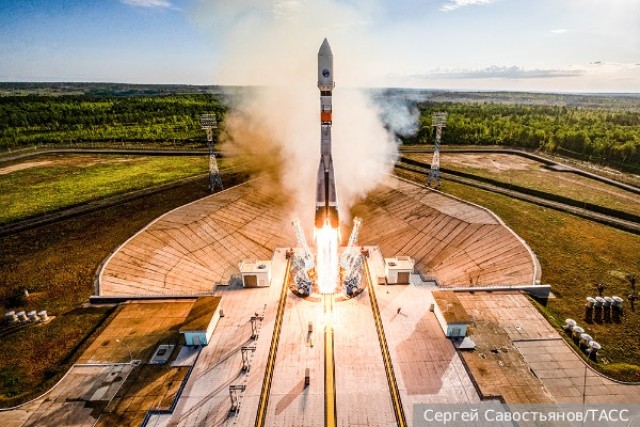Russia has put into orbit a spacecraft carrying breakthrough technologies for our country on board. Its tasks are primarily exclusively peaceful – concerning, for example, the functioning of the Northern Sea Route. However, they are not limited to this. Why is this device so important for Russian cosmonautics, including for our military?On May 27, 2023, the Condor-FKA spacecraft was launched into orbit from the Vostochny cosmodrome using a Soyuz-2.1a carrier rocket with a Fregat upper stage.
It is a small spacecraft for remote sensing of the Earth, designed to obtain radar images of high and medium resolution.
The designation "small" refers only to the size and weight of the satellite and means that its weight is less than 1,500 kilograms. At the same time, according to its characteristics, the Condor-FKA is really a breakthrough device.
It so happened that the Russian orbital grouping of devices observing our planet in recent years did not have a radar satellite in its composition. The last spacecraft of the Condor series, numbered 1 and 2, were launched in 2013 and 2014, respectively. By the way, both Condors became the payload for two launches of the Strela carrier rocket - conversions from the RS–18 intercontinental ballistic missile (UR-100N).
At the same time, radar devices are very necessary for both the Russian military and scientists. The thing is that satellites that take pictures of the Earth's surface in the optical and infrared ranges are very weather-dependent. When it is cloudy or at night, they cannot be used to get high-quality images.
And if we are talking about mapping, this is not a problem, you can always wait. But if operational information is required, for example, for defense purposes, this can become a problem.
In this case, the best solution is spacecraft to create radar images. They work on the basis of radio waves emitted from satellites in the direction of the Earth. Reflecting off objects on the surface of our planet, they return back to the satellite. With the help of an antenna, the reflected waves are recorded and processed using computer algorithms.
As the spacecraft moves in orbit, radio waves are emitted at different angles, which allows for a full volumetric scan of the Earth's surface. The information transmitted by the satellite is used to build high-resolution maps, detect objects on Earth, and monitor natural phenomena such as earthquakes, floods and forest fires.
Radars can operate in various frequency ranges, including the L-, C-, X-, Ku- and Ka- bands. Each range has its own characteristics and can be used to perform certain tasks. For example, the Ku frequency range is used to measure the height of the sea surface, and the Ka frequency range is used to detect atmospheric phenomena such as fog or rain.
At the same time, the satellite scans at any time of the day, regardless of the weather. For example, this is very important for determining the ice situation on the Northern Sea Route, most of the time covered by clouds, or monitoring the movement of enemy equipment.
Consumers of satellite images, however, are declared as exclusively civilian: the Ministry of Agriculture, the Ministry of Emergency Situations, Rosreestr, Roshydromet. Condor-FKA devices provide shooting of the Earth's surface around the clock and regardless of weather conditions and clouds. Which actually means guaranteed image acquisition within the stated time," says one of the satellite developers, chief designer in the direction – Director of the Joint Directorate of Space Systems of the NPO Mashinostroenie Alexey Worker. According to him, "in fact, one hundred percent use of the domestic electronic component base in the instruments and systems of the spacecraft has been achieved."
But this is only part of the possible use of such devices. One of the possible applications of radar satellites is radar interferometry. It allows you to detect displacements of the Earth's surface and objects located on it with centimeter accuracy (for the Earth's surface) and several millimeters (for buildings and structures).
According to open information, the spacecraft of the Condor series can receive detailed images with a resolution of up to one meter in any weather and at any time of the day with a passage band of up to 120 km in the survey mode. It is assumed that already in 2024, the Condor-FKA No. 2 will go into orbit, bringing the grouping to the estimated number of two vehicles.
Near-polar sun-synchronous orbits, offset from each other by 8.88°, were chosen as working orbits. This will make it possible to conduct a highly operational interferometric survey. According to again open data, the system of two devices should provide the ability to transmit to earth every day at least 200 conditional frames of 10x10 km, made with a resolution of 1-2 m.
Currently, work is underway on an even more modern version of the Condor–FKA-M series of devices.
It assumes changing the geometry of the radar and replacing the horn irradiator with an irradiator with an active antenna-feeder array. This will improve the characteristics of radar shooting, increase the angles of electronic scanning on two planes, which will allow you to achieve a resolution of up to 0.5 meters when shooting in detail. In addition, the available power of the space platform and the energy characteristics of the radar will be increased, which will significantly improve the radio technical characteristics of the received radar images.
In the meantime, you can rejoice at the successful breeding of the first "Condor-FKA". We hope that the first pictures will be shown soon. That's when you definitely won't run away from the Russian satellite grouping, you won't hide.
Mikhail Kotov

